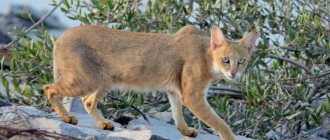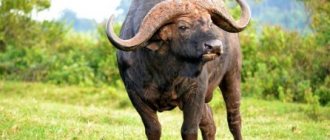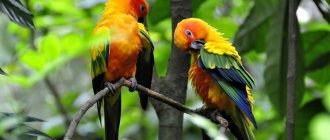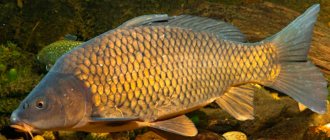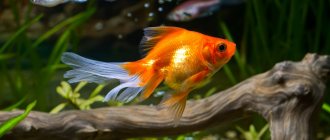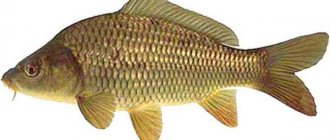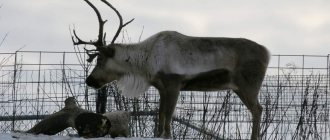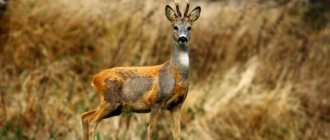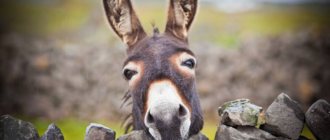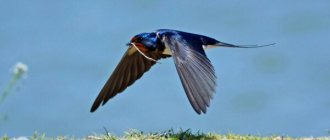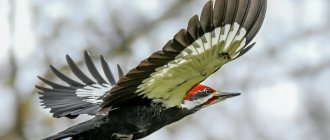Wolverine is a predatory and dangerous mammal from the mustelidae family with an unusual character and appearance. This predator, which looks like a hybrid of a small bear and a sable, is also called the wolverine.
Local aborigines used to think that wolverines were bear cubs that could not grow up. Some peoples consider the wolverine to be a holy animal, while others consider it to be a devilish animal. This is such a mysterious beast.
The animal is not like its closest relatives from the family - mink, sable, harza, marten, badger and others. Look at the photo to see what this animal and its cub look like.
Wolverine and cub
This predatory animal lives in the taiga and forest-tundra of many countries, including Russia. But since the animal is very careful and secretive, it is extremely difficult to detect it. Just look at his tracks in the snow, which are very similar to those of a bear! And the ferocity and enormous strength for its size helps the predator defeat even a wolf or a lynx!
The animal's claws are so sharp that they can easily rip open the belly of any animal. Maybe that's why they made a film about Wolverine with his memorable claws from actor Hugh Jackman.
In the article I will tell you everything about the wolverine: a full description of the animal, what it looks like, where it lives, what it eats, lifestyle, natural enemies and interesting facts! I promise it will be interesting!
Scientific classification
Systematic group of wolverine:
| Domain | Eukaryotes |
| Kingdom | Animals |
| Type | Chordata |
| Class | Mammals |
| Squad | Predatory |
| Family | Musteluns |
| Genus | Gulo Pallas, 1780 |
| View | Wolverine |
| International scientific name | Gulo gulo Linnaeus, 1758 |
What kind of animal is this wolverine?
Where did the name "wolverine" come from? The word "wolverine" is translated from Latin as "glutton", and is written Gulo gulo. This scientific term was first used by Carl Linnaeus in 1758.
What does the word "wolverine" mean? This word comes from the Finnish “rasva-maha”, which literally translates as “fat belly” . This name has taken root not only in Russia, but also in Poland (rosomák) and Hungary (rozsomák). In America, the wolverine is called wolwerine, which translates as “small wolf.” In Norway, the animal was previously called fjellfross, which means “mountain whale”.
In French, wolverine is spelled glouton, in German - velfraß, which literally translates as “insatiable glutton.”
Why is the wolverine called that? This is due to the animal’s excellent appetite. This predator is called the demon of the north, the forest demon, as well as the devil or skunk bear, because it can emit a pungent and unpleasant odor, as do all representatives of the mustelid family.
The Sami on the Kola Peninsula considered the wolverine to be a demonic creature. Indeed, if you carefully study the appearance of the predator, you might think that this is the fruit of the devilish love of a badger and a bear. The predator took lush fur and club feet from the bear, and short legs and coloring from the badger.
Wolverines have no sense of satiety
A long time ago, scientists doubted whether to classify the animal as a canid or a weasel. The wolverine now belongs to the mustelidae family, and is the only representative of the genus Gulo and the species Gulo.
The wolverine's type of symmetry is bilaterally symmetrical, that is, the right and left halves of the animal's body mirror each other. This type of symmetry is present in 99% of all described animals. The predator belongs to the plantigrade type of animal, that is, when walking, it rests on its entire paw.
The beast is still poorly studied by naturalists because it is very secretive and extremely aggressive.
What does a wolverine look like?
Who is Wolverine? What is this animal about which we know so little information? Wolverine resembles a brown bear, but is the size of a medium-sized dog.
Wolverine dimensions: weight - 11-19 kg, and in some cases the male can weigh up to 30 kg. Female wolverines are 10% smaller in size than males and 30% lighter. The length of the predator is 70-86 cm, and the tail is 18-23 cm. The height at the withers is up to half a meter.
If you look at a wolverine from a distance, it looks like a hybrid of a bear cub and a badger. The predator has a clumsy and stocky body, short legs, and the hind limbs are longer than the front ones. Therefore, the wolverine's back is arched upward.
From afar, Wolverine looks like a little bear cub
The wolverine's head is large, its muzzle is elongated and blunt in front. The eyes are small, the ears are slightly rounded. The tail is bushy and not very long. The feet are large: 10 cm wide and 9 cm long. This property helps the wolverine walk even on very loose and deep snow. Such wide paws are even more noticeable in summer due to the fact that the animal sheds.
Wolverine looks like a clumsy animal
The predator's fur is lush, long, but hard and loosely fitting to the body. The longest hair is located on the sides and back of the animal’s body, which looks like a kind of “skirt”. The undercoat has a hydrophobic feature, so in the cold the wool does not become covered with frost, does not get wet or cake. And if the animal lies on the snow for a long time, then it will not melt under it. This is due to very good thermal insulation.
Almost white wolverine
The color of the wolverine's skin is brown, dark brown, light brown or brown-black. The paws are often almost black in color. On the wolverine's face there is a light mask in the shape of a stripe. There is a light-colored collar in the chest area and on the neck, and a light pattern on the sides and base of the tail.
The skin color of a wolverine is most often dark brown.
The wolverine has a peculiar stripe - a harness that runs along the head and sides to the back of the body, which can be yellow or golden in color. In the summer, the wolverine sheds, its fur becomes shorter and less beautiful. And in winter it grows, becomes more beautiful, thicker and longer. This helps the animal protect itself from severe frosts and dig deep tunnels in the snow to get its supplies. Wolverine can hide in a large snowdrift for 2-3 days.
The wolverine has anal glands that spray a secretion 3 meters away; it is very sharp and unpleasant. This helps to intimidate enemies and take food away from larger predators. There is an additional gland on the animal’s belly, with which it rubs against stones and branches, marking the boundaries of its habitat, and during mating games it attracts females.
What kind of claws does a wolverine have? They are large and sharp, reminiscent of hooks. How many claws does a wolverine have? Each webbed foot has 5 toes with claws. The membranes help the animal to easily move through the snow. No animal has such long claws. The razor-like claws can tear apart even very large prey. They also help the animal to easily climb trees and rocks, dig the ground, and get through very hard-to-reach places. But the wolverine prefers a terrestrial lifestyle and can swim well in water.
What do wolverine claws look like?
Wolverine's teeth have sharp edges, which are a serious weapon. Thanks to its powerful jaws, the animal can chew even icy remains of meat and large bones.
How does a wolverine walk? When moving, the animal places its paw on the entire foot, which causes clubfoot. And the widely spaced paws give the wolverine a disproportionate appearance. But, despite this, the predator moves deftly and quickly, which allows it to easily escape from its enemies.
What does a real wolverine footprint look like in the snow?
Hunters can often confuse wolverine tracks with those of a young bear or lynx. The area of a wolverine's footprint is the same as that of a bear.
The difference between wolverine tracks and bear tracks
There is another feature of the predator. This is the shape of the chest, which each individual has its own unique shape.
Biologists say that the Siberian queen has excellent eyesight and sense of smell, but her hearing leaves much to be desired.
physical characteristics
Wolverine is a very stocky and muscular animal. Only the giant otters that live in the Amazon Valley and sea otters are larger in size than this member of the mustelid family.
Appearance
Photo: ichuck
The wolverine has short powerful limbs, a thick rounded neck, small round ears and small eyes. Although the animal's limbs are not very long, its large five-toed paws make it easier to move through deep snow. The weight of the animal primarily falls on the metatarsals, so it does not sag on loose snow. So in the snow, this predator is more likely to catch large animals that get stuck in deep snow. But on hard ground, ungulates can easily outrun a wolverine.
Coloring
The wolverine has thick, dark, oily fur that is highly hydrophobic, making it resistant to frost . This was the reason for its traditional popularity among hunters, who used wolverine fur as a lining for jackets. Wolverines typically have tan or brownish-black fur with a yellow or gold stripe running from the top of the head along the sides of each shoulder and to the rump where the stripes meet at the tail.
Like other stoats, wolverines have powerful anal scent glands used to mark territory and provide sexual signals. Because of its strong odor, the wolverine has earned the nickname "nasty cat" and is often compared to a skunk.
Dimensions
Photo: Paul Cools
These terrestrial mammals are characterized by sexual dimorphism. Male wolverines are 10-30% larger than females in linear dimensions and can even be twice as heavy as them.
- Body length: from 65 to 107 cm
- Shoulder height: from 30 to 45 cm
- Tail length: 17 to 26 cm
- Weight: from 9 to 25 kg, males can weigh up to 32 kg
Subspecies
There are 5 subspecies of the common wolverine in the wild. Species depend on habitat. The American wolverine (lat. Gulo gulo luscus) lives in North America, and the other 4 species live in Russia.
North American wolverine
What kind of wolverines are found in Russia:
- Northeastern wolverine (lat. Gulo gulo albus). This is the largest representative of all subspecies. Has the lightest skin. The light stripe running along the body is the widest and is larger than the main color of the coat. Dark coloring remains only on the tail, paws and slightly in the center of the back. The northeastern predator lives near the Sea of Okhotsk and the Kolyma River.
Northeastern wolverine - European wolverine (lat. Gulo gulo gulo). It is large in size and has a mostly dark coat. The light stripe is thin and difficult to distinguish on dark fur. Habitat: Scandinavian Peninsula, northeast of Eurasia from Karelia to the Pechora River.
European wolverine - Siberian wolverine (lat. Gulo gulo sibiricus). This is the smallest individual. It is distinguished by a thin light stripe that reaches only to the middle of the tail. It lives throughout Western Siberia, up to Altai and Kazakhstan.
Siberian wolverine - Yakut wolverine (lat. Gulo gulo jacutensis). A medium-sized predator with 2 color types. Animals living in the south are dark in color, while animals in the east and north are light in color. The Yakut predator lives on the right side of the Yenisei River to Kolyma, in Mongolia and China.
Yakut wolverine
Where does the wolverine live?
What continent does the wolverine live on? The animal is found only in North America and Eurasia. The general distribution and biological distribution is directly related to the presence of large ungulates in the forests. Here is a list of habitats where the predator lives:
- Scandinavian Peninsula;
- Russia;
- Finland;
- Kazakhstan;
- Sweden;
- Norway;
- Arctic;
- Estonia;
- Lithuania;
- China;
- Mongolia;
- USA;
- Canada;
- Latvia;
- Poland;
- Ukraine;
- Belarus.
Here are the places where the wolverine appears and lives in Russia:
- Perm region;
- Kirov region;
- Tver region;
- Leningrad region;
- Vologda Region;
- Siberia;
- Altai region;
- Far East;
- Kola Peninsula;
- Karelia;
- Pskov region;
- Komi Republic;
- Kamchatka;
- Novgorod region.
Where is the wolverine found on the map
But, even knowing those parts of the forest where the wolverine lives in Russia, it is almost impossible to just meet him in the forest, because she always avoids meeting people. As forests are being actively cut down in Siberia, the wolverine is moving further north.
What forests does the wolverine live in? Most often, the wolverine is found in such natural areas as taiga, forest-tundra, tundra, mountain tundra, and Arctic islands. The wolverine is not found in steppes and similar places, since it prefers a habitat with many trees and shrubs, where it can hide from enemies and where there are many ungulates.
The animal's skin reliably protects it from the most severe frosts. The predator does not have a specific territory; it is always on the move and stops in those places where prey is found.
Finding several wolverines in the same territory is almost impossible. But one day one of the biologists saw several animals in the Sikhote-Alin mountains. According to calculations, each wolverine occupied an area of 100 km², which is considered a very small habitat. And in total, according to estimates, no more than 400 animals live in these places.
Habits
Wolverines are known for their endurance and tirelessness. These qualities help them in hunting. The predator is able to pursue prey for a long time until it becomes exhausted. live and hunt alone . It is very rare that they organize a joint hunt for big game. In this case, two or three wolverines act thoughtfully and harmoniously. When one pursues the beast, the others wait for it in a certain place and unexpectedly attack. Game taken by surprise is eaten together.
They are unpretentious in food and are content with any prey. They can go without food for more than 7 days . However, they became famous for their gluttony. Therefore, they received the Latin name “glutton”. Energy reserves accumulate in the body in the form of fat.
Favorite food is carrion. It has the ability to smell the blood of a wounded animal or the smell of decaying remains from several kilometers away. Prefers to eat animals killed by other predators. But the wolverine herself became famous as a successful hunter. Usually hides in a tree waiting for suitable prey. He jumps from above onto his back and breaks his spine or gnaws an artery with his teeth. He eats most of the meat immediately, and hides the rest in reserve. The wolverine hunts various ungulates (deer, roe deer, elk), wild birds, and rodents. In summer, it destroys nests in search of eggs. In winter he fishes in the river . Does not disdain plant foods: plant roots, berries, nuts, mushrooms.
And, above all, the wolverine performs a sanitary function. It is estimated that out of 10 ungulates eaten by it, only three were obtained independently. The rest are prey or carrion taken from others. Since sick individuals die first, the wolverine is also at risk of infection. Forest nurses themselves often die from infections.
The animal is active at night. During the day, the wolverine rarely goes hunting, preferring to hide in a shelter. The beast does not have a permanent lair, because it is always on the move and does not stay in one place for a long time. It roosts during the day in rock crevices and trees. In winter it makes holes in the snow.
What does a wolverine eat?
What does a wolverine eat in the wild? This predator eats whatever it can find. Most often, wolverines eat carrion: the remains of the prey of large predators (wolves, bears), which they find by the cries of crows. There have also been recorded cases of animals eating human corpses. The jaws of a predator can easily grind even the large bones of its prey.
Wolverine teeth can even cope with animal femurs
Wolverines eat carrion even more than the main orderlies of the forest - wolves. According to statistics, 70% of a wolverine's food is carrion, and 30% is the animals it hunts.
When a predator attacks the trail of a wounded animal, it follows the trail for a long time and stubbornly, and when it finds it, it kills and eats it. Frequent victims of wolverines include young, old and sick animals. Wolverine sits in ambush, and when an animal appears, he quickly rushes at him. As a rule, it jumps on the back of the victim and bites its carotid artery. Even adult animals die with such wounds.
The predator feeds until it is completely full. What is left, the wolverine hides between rocks, underground or snow, and lives nearby as long as there is a supply of food.
If the Siberian queen sees an animal that has fallen into a trap, she attacks it, grabbing it by the throat, and then eats it. In these cases, sable and marten often become prey.
It is not easy for a wolverine to obtain live prey, because the animal’s speed is relatively low. But since the wolverine is a hardy predator, it can pursue its prey for several hours until it catches up with it. The predator loves to feast on rodents and ground birds.
The wolverine's main food is carrion.
List of animals that wolverine hunts:
- Wild land birds: geese, black grouse, capercaillie, hazel grouse, partridge;
- Marmot;
- Squirrel;
- Fox;
- White hare;
- Porcupine;
- Beaver;
- Gopher;
- Pika;
- Roe;
- Different types of deer;
- Elk;
- Rams and goats;
- Musk deer;
- Mole;
- Rodents – voles, mice, chipmunks, rats;
- Reptiles;
- Fish.
Wolverine loves to fish, which he hunts in summer and winter. In cold weather, the predator knows places where there are polynyas - unfrozen water on the surface of the river, where it catches fish. She also eats dead fish thrown ashore (dead fish) when there is a massive spawning of salmon fish.
In summer, the predator likes to feast on bird eggs, honey, berries, pine nuts, fruits and wasp larvae. If the victim gets stuck in the snow, trying to get away from the wolverine, then she can no longer escape - the predator cleverly kills her.
Wolverine is quite an omnivorous predator
Wolverine hunts at night and always alone. Multiple animals can only gather when they eat a large animal carcass and during mating.
If a predator fasts for several days, then it can take food from its competitors - fox, sable, wolf or lynx. Wolverine sprays a pungent odor from his glands, which scares away all animals. Animals sense the Siberian queen by smell, so they abandon their prey so as not to encounter her.
Wolverine is a very smart and attentive animal, so it can pull prey straight out of traps, and it almost never falls into traps. But if she gets her paw into a trap, she chews it off. Sometimes wolverines can drive bears out of raspberry bushes, which are feasting on the berries there.
In Eastern Siberia and the Far East, wolverines form groups to hunt adult musk deer. When they hunt it, the musk deer moves away from them in circles. When one wolverine chases an animal in a circle, other relatives surround it, narrowing the circle and driving the victim into a trap. A musk deer carcass is enough to feed a wolverine for 4 days.
Wolverine starves his prey to death
The predator can go without food for up to 7 days in a row, but after that it quickly replenishes vitality and weight . Wolverine is a real glutton: he can eat more meat than his own weight. This is due to the fact that the predator is not always lucky with its prey, especially in winter. In the summer, wolverines move less often from place to place, because the prey becomes much larger and more varied.
How does a wolverine hunt? The predator prefers to eat ungulates, so he always knows where they graze. The hunt begins with the animal following the herd for some time. When a wolverine chooses a victim, it begins to run after it many meters forward and sometimes stops to assess how much strength it has to chase. Wolverine always starves his prey to death if he starts hunting him.
A long pursuit greatly exhausts the future prey, and then the wolverine makes a fatal leap, knocking the victim onto its side. Wolverine digs into the animal with his sharp claws and teeth until he kills it. Wolverines living in Eurasia are hunted more often than in North America.
Food for wolverines
Since wolverines are predators, their diet mainly consists of animal food. They feed on mouse-like rodents, hazel grouse, black grouse, and sometimes what is left from the hunt of bears and wolves. If the animal has nothing to eat, it can attack the wolf itself (but this happens rarely) or recapture their prey from him or the lynx. Sometimes wolverines hunt large ungulates; wounded, sick or young animals become their prey. Wolverine can kill an animal that is 5 times taller than itself! But this happens mainly in winter. High snow cover makes it difficult for animals to move; wolverines take advantage of this and attack their potential prey. These predators are able to pursue prey for a long time, as they are distinguished by their endurance.
This time the wolverine is not averse to eating honey, berries, wasp larvae, bird eggs, and lemmings (rodents). Like the bear, the wolverine fishes during spawning or near wormwood. Moreover, she eats not only fresh fish, but does not disdain already dried fish.
Wolverines hunt birds not only when they are on the ground, but also in nests, since these animals, despite their external clumsiness, perfectly climb trees and cling to trunks and thick branches.
Even a bear tries to avoid an angry and aggressive animal if it meets a wolverine. She can drive the bear away from his own prey and take the trophy for herself. Although these animals hunt well, they prefer to save energy and, if possible, eat carrion. In this they are also similar to bears.
Lifestyle
Basically, the predator lives alone and does not allow relatives of the same sex into its habitat. If a competing predator or a male wolverine comes to the territory, the Siberian animal will fiercely defend its possessions, and the fight should end in the death of one of the animals. Males rarely come to another male's property.
Northern wolverines lead a lifestyle alternating 4 hours of sleep and activity. In winter, the area is poorly guarded.
Animals lead a sedentary lifestyle only during the period of raising their young. Wolverine makes a lair for resting in dead wood, rock crevices, or under uprooted tree roots. If there are no secluded places, she rests on rocky terrain or snow.
The animal sleeps most of the day, but it can change its daily routine if necessary. The wolverine comes out to feed at dusk or at night. Unlike other representatives of the mustelid family, the wolverine does not lead a sedentary lifestyle. She constantly moves around her habitat in search of prey.
If there is plenty of prey, then the wolverine rests most of the day
The habitat area can be up to 2 thousand km. If she lives near a herd of deer in the forest, then the area of her property may be only 2 km². When the herd goes elsewhere, the wolverine follows. On average, males have a territory of 620 to 1000 km², while females have 2-3 times less territory. Several females can live on the territory of a male, and they do not collide with each other.
The predator marks the boundaries with odorous marks that smell sharply. He is not only greedy for food, but also pathologically obsessed with his territory.
On average, a tramp in the northern forests can walk around his property in 3-5 days, moving 30-80 km per day at low speed. She moves sideways or in the form of jumps, stoops and looks clumsy in appearance. Watch how wolverine runs:
When moving, the hardy wolverine does not take into account the time of day and stops to rest after it runs out of strength. The predator can stand on its hind legs to look around.
Wolverine inspects his possessions
The predator climbs trees very well due to its tenacious and long claws. Therefore, it can easily climb into bird nests, tree hollows and holes in search of food.
How does a wolverine talk? She makes sounds that resemble the rough barking of a fox. And when she is angry, she makes a growl or grunt. Listen to her voice here:
A predator can kill a prey that is 4-5 times larger than itself, provided that the prey gets stuck in deep snow. A wolverine can attack a person only if it is driven into a trap.
Wolverine is not afraid of anything, she is dangerous and ferocious, she uses a pungent smell, sharp claws and teeth against her enemies. Even bears try not to get close to the predator if possible.
Bear runs away from wolverine
When moving, the wolverine is very careful: it can move along the paths of hunters and animals, traces of skis and snowmobiles without giving itself away. Therefore, the animals have been little studied, and there are also few photographs and video materials.
The predator’s sense of smell is simply excellent: it was recorded how the wolverine smelled a dead fish under a meter-long layer of snow and quickly dug it out with the help of its strong paws. Often the wolverine destroys the tents, huts, and winter quarters of hunters, deftly pulling the bait out of the traps.
Thus, the wolverine can move everywhere: in deep snow, trees, and water. She has a ferocious character and an unusually resilient organism. A devilish creature, and nothing more! Especially when she opens her mouth in aggression and begins to resemble a demonic creature.
Wolverine in a rage resembles a terrible creature from the underworld
Wolverine is capable of killing a wolf with one bite, and driving a lynx up a tree like a frightened kitten, despite the fact that it is smaller in size. And after jumping on the back of the prey, it will bite into the animal’s scruff until it dies. The wolverine has so much strength that it effortlessly climbs a tall tree with the heavy head of an elk, running away from hunters.
Characteristics and description
Compared to other predatory mammals, the wolverine is not distinguished by its impressive size, menacing appearance or grace. At the same time, this is a very dangerous animal: the wolverine is one of the few predators capable of killing larger animals. She successfully hunts elk, deer and other artiodactyls that are many times larger than herself. In addition to herbivores, wolves and other small predatory forest inhabitants can become victims of wolverines. Despite the fearlessness and aggressiveness of this mustelid species, cases of wolverine attacks on humans are practically never recorded. The exception is when the animal is in a hopeless situation and is forced to attack to save itself.
One of the main differences from other members of the family is the ability of the wolverine to secrete a secretion with a rather strong unpleasant odor. It is formed in the paraanal glands and is used by the animal to leave sharply smelling traces on the borders of its territory, as well as to scare away enemies. This feature and the results of genetic studies indicate a certain similarity and relationship between the wolverine and the skunk, which for a long time belonged to the mustelids and only recently were identified as a separate family.
Wolverines are distinguished by acute vision, good hearing and sense of smell. They are very smart and resilient, orientate well in the dark, and are able to ambush in trees or hills.
What does the animal look like
The appearance of wolverine has the following features:
- the body is short and stocky; in the cold season, due to the fluffier and longer fur, the animal looks larger;
- the tail is wide, the length is equal to a quarter of the length of the body;
- the head is round with an elongated muzzle, a large nose and small rounded ears;
- the paws are thick, the hind limbs are longer, which is why the animal looks disproportionate and clumsy;
- The feet of the paws are very wide and covered with fur except for the pads; the toes end in sharp claws.
The clumsiness of wolverines is deceptive: during the hunt, they are capable of making very accurate and fast throws, killing the victim with one bite to the neck. They differ from other predators in their amazing endurance, ability to swim, climb trees, and travel long distances with virtually no rest.
The body color is dark brown, the paws are covered with darker, almost black fur. There are two light-colored stripes along the sides of the body. The animal sheds twice a year, and the fur that grows in late autumn is denser and longer.
How much does it weigh
The newly born cubs weigh about 100 grams. The weight of a wolverine that has reached sexual maturity ranges from 10 to 20 kg. Males are usually a third heavier than females and noticeably larger. Thus, the height of a large male reaches 50 cm, and the body length is 85 cm, while in a female the corresponding indicators are between 40 and 70 cm.
How many years does he live?
The average lifespan of a wolverine in its natural habitat is 10-12 years. Individuals kept in captivity can live up to 15-17 years or more.
Behavior
Although the wolverine is considered a true killing machine, there is evidence that this animal often simply pretends to be more ferocious than it really is.
Scientists have proven that the demonic dance that she demonstrates during a meeting with an enemy serves only to scare away and nothing more. When biologists pursued the wolverine, he drove it into a trap - dense spruce thickets. Wolverine began to hiss and scream loudly. But people still continued to attack her. As a result, the predator ran away, screaming angrily. Thus, the animal simply imitated a threatening appearance when it was pressed against the wall.
The wolverine's furious face probably serves only to scare away
Most likely, this behavior is due to the fact that it compensates for its small size compared to other, larger competitor predators. When encountering a bear, Wolverine will test its willpower by screaming loudly at it. For her, it is better to scare a large predator than to engage in a fight, from which the wolverine does not always emerge victorious.
Even actor Hugh Jackman, who played Wolverine in the film of the same name, proved to the audience that there was something more hidden under the mask of a ferocious predator. The wolverine has very flexible behavior, which was found out during the experiment.
Hugh Jackman was able to show some of the habits of predators in films
They hung a beaver carcass from a tree and monitored the wolverines. The first wolverine, before starting to eat, sniffed everything around and looked around. The second predator damaged several surveillance cameras before feeding. The third one ran to the prey, grabbed it and immediately ran away.
Diversity in behavior patterns was observed in places where animals felt protected. And in places where other predators lived, wolverines behaved as described in case 2. Scientists still cannot answer what is the reason for such different behavior.
Is it possible to keep wolverines at home?
When deciding this issue, do not forget that wolverines are quite large predators. It’s even scary to imagine what they can do if a person offends them or behaves in a way that angers the beast. It is believed that if you take an animal in infancy, it can be tamed. But, of course, wolverines need to be kept in cages and released to roam in a fenced enclosure, observing all safety rules. However, it is better to leave the maintenance and taming of wolverines to professional zoologists who are well aware of all the intricacies of this difficult task, will be able to properly feed the animal and provide the individual with the space necessary for its full life. Wolverines have another interesting property that makes them difficult to keep at home. Like skunks, when in danger or fear, wolverines can release a foul-smelling stream. Experienced hunters say that if this stream hits hunting dogs, they may lose the sharpness of their senses. If a wolverine marks a person with this secretion, the smell can last up to ten days. Therefore, it is better to watch this animal on TV screens, in the zoo - it is much safer than deciding to buy an animal for your home.
Animal photos:
Author: Veronika Tsvetkova for TutKnow.ru
Wolverine breeding and cubs
The male and female pair up once a year: from May to August. Sometimes animals can unite for joint hunting as early as March. Wolverine is capable of giving birth to cubs once every 2-3 years. Males at this time fight fiercely for the female.
How wolverines fight
Wolverines live together for only 2-3 weeks. Sometimes males can have 2-3 females at the same time and can feed females who feed their babies with breast milk.
Mating in a pair occurs only 2-3 times, before which a mating game occurs, associated with the aggressive capture of the female. After mating, the male and female separate. The female begins the so-called latent period of pregnancy. This is a delay in embryo development, which is characteristic of almost all representatives of the mustelid family. The delay in embryo development lasts from 7 to 8 months, and then effective pregnancy begins, lasting 30-40 days.
Cubs are born in February-March, in a hidden place. Most often, she digs a den, the length of which is up to 40 meters, to which at least two holes lead. The female does not make the shelter particularly comfortable, as if preparing her cubs for the harsh nomadic life. Not far from the den, the female makes many storehouses with prey in order to feed on it for several weeks while the babies are small.
Wolverine cubs in the photo
On average, 2-4 blind babies are born, weighing 100 grams each. The skin of puppies is already covered with short and fluffy light fur. Wolverine is weakly protective of her cubs, but in case of danger she can fiercely defend them.
What is the name of a baby wolverine? His name is puppy. A month after birth, he gains weight up to 500 grams.
A month after birth, the puppies open their eyes and feed on their mother’s milk for 2.5 months. Visually, babies already look like adult animals, although their weight is still very small.
After 3 months, the female feeds the cubs with semi-digested prey. And during this period, at the beginning of summer, the babies leave the den for the first time. Around the mother, during long movements in search of prey, the puppies live for about 2 years, and then begin to live independently.
Grown up wolverine puppy
The male does not take any part in raising the babies. Wolverines become sexually mature by the age of 2, but they do not develop physically until they are 3-4 years old.
Wolverine: description
This predator represents both the family and the subfamily “mustelidae”. The wolverine is considered a large representative of this family, although the sea otter is still larger than the wolverine. The size of this predator is comparable to the size of a large dog, and its appearance is more reminiscent of a badger or a bear with fluffy, but not too long, fur, as well as a tail. The length of an adult predator is about 80 cm, and its weight is no more than 15 kilograms, although males are a couple of kilograms heavier. At the same time, there are individuals weighing about 20 kilograms.
The wolverine's muzzle is similar to that of a bear, and the head is large and has small, neat ears, with a noticeable rounding. The eyes are black, as is the nose. The body is dense and squat, set on thick but short legs. The forelimbs are somewhat shorter than the hind limbs, which is why the hindquarters of the body are noticeably raised, creating the appearance of some hunching.
This animal has an almost square shape, five-toed feet, about 10 cm in diameter. Relatively large feet are armed with hooked claws, which allows the animal to easily move through deep snow and also easily climb trees. Wolverine can be easily distinguished from other animals by its tracks, since it walks using its entire foot, leaving a clubfoot trail.
In summer, the wolverine has fairly short fur, but it still hides its disproportionately large head and limbs. In summer this animal looks completely unattractive. With the arrival of real cold weather, the wolverine begins to grow fur, which makes the animal more natural, natural and proportional. The color of the coat is dark brown or black, and a lighter, wider stripe is clearly visible on both sides.
Interesting to know! Under the shaggy fur hides a fairly strong skeleton. At first glance, this is a rather clumsy animal, but in fact this predator has fast and lightning-fast movements.
WOLVERINE - INTERESTING FACTS ABOUT ANIMALS
Habitat
This predatory animal is distributed over large areas located in the subpolar and temperate climatic zones of North America and Eurasia. Wolverine lives in the remote taiga in the north, on the Arctic islands, in the forest-tundra and tundra, where there are enough wild animals and there are no problems with food.
This predator is the official symbol of the American state of Michigan and is often called the “Wolverine State.” As for the European continent, this animal lives in the north of Scandinavia, Finland, Poland, Latvia, Estonia, Lithuania, Belarus and Russia.
The predator is found in Siberia, the Kola Peninsula, Karelia, the Far East, Kamchatka, etc. The southern border of the habitat ends in the Kirov, Tver, Leningrad, Pskov, Vologda and Novgorod regions.
It is almost impossible to see a concentration of wolverines, although one of the naturalists described a similar phenomenon that was observed in the Sikhote-Alin mountains. Moreover, one individual occupied an area of about 100 square kilometers. This became possible due to the high density of moose living in this territory at that time. As far as we know, about four hundred individuals live in the vast expanses of the Ussuri region, and no more than 2 thousand in Yakutia.
Natural enemies of wolverine
All representatives of the mustelid family are characterized by the fact that they have anal glands that secrete a special secretion. At the same time, Wolverine uses it:
- To attract members of the opposite sex.
- To mark your territory.
- To scare away enemies.
This secret has a unique smell, which allows the wolverine to easily take prey from a lynx or wolf. This impudence can be explained quite simply: since the lynx is a fairly clean animal, it tries to get away from this smelly predator as quickly as possible.
According to some hunters, the wolverine itself can attack the wolf, ultimately using its secret weapon - a disgusting smell. Wolverine is a very aggressive animal that even bears avoid. A person can only be attacked as a last resort if she has no other choice.
Interesting fact! Many experts note the strength, speed, endurance and fearlessness of this predator, since it can even withstand a bear or a tiger, but at the same time it will not shed its blood in vain. In other words, it acts within reason.
At one time, hunters claimed that this animal steals food products, mainly meat, from storage areas, as well as animals from traps. As a result, they began to call the wolverine a “dirty predator” and began to practice shooting these animals when necessary and when not necessary. Sometimes hunters were even paid bonuses for the destruction of individuals.
Quite recently, when the habits of this animal were thoroughly studied, the wolverine was no longer persecuted. As for stealing food from taiga warehouses, brown bears do this. As for wolverines, they try to avoid places where people stop.
Behavior and lifestyle
Wolverine prefers to be constantly on the move. Therefore, she wanders from place to place in search of food, but only within her territory. The predator goes hunting after dark.
While in search of food, the wolverine looks into tree hollows, into nests, into holes, under tree snags, and into dead wood. At the same time, she climbs trees without much effort, thanks to the presence of tenacious claws and strong paws.
Wolverine fiercely defends his territory from the encroachments of his relatives. Being constantly in motion, it can temporarily stop in dead wood, in the roots of uprooted trees, in rocky crevices, etc. Even if there is no such type of shelter, a wolverine can easily settle down on rocks or snow.
Important fact! Wolverine is an excellent swimmer, so any water obstacles are not a problem for this animal. In addition, the predator has excellent vision and hearing, but the sense of smell is not particularly acute.
Wolverine, despite his fearlessness, is also a cautious animal. She can move unnoticed along the paths of hunters and various animals, which allows her to always find food for herself. She can also use a snowmobile trail or a regular ski track without any problems.
It should be noted that the wolverine is not a fast animal, but it is quite hardy, since the wolverine covers up to 30 kilometers per day. It moves in leaps and bounds or, as it were, sideways. Experts know of cases where a wolverine covered 70 kilometers without stopping. In a day they can cover at least 80 kilometers, and in a couple of weeks a distance of 250 kilometers is a given.
Experts say that when moving, the wolverine is not guided by the time of day and rests when it is exhausted.
Versus. What is a wolverine capable of? Wolves and even bears are afraid of her!!!
Wolverine nutrition
The diet of this predator is very extensive, although it does not always manage to catch a small, nimble animal or kill a large animal, although such cases do occur. This predator is capable of driving down a healthy elk or deer, especially in deep snow. Animals that cannot get out of deep snow will not escape the wolverine. If we talk about sick or injured animals, then this is exactly what the wolverine needs. She happily picks up the remains of food that bears or wolves leave behind. The wolverine is alerted to carrion by the cries of birds, which also do not mind feasting on the remnants of wild animals’ feasts.
Wolverines are real forest orderlies, since 70 percent of their diet consists of food scraps and they obtain only 30 percent on their own, ridding the forest of weak and sick wild animals.
Interesting to know! In the regions of Eastern Siberia and the Far East, these predators practice joint hunting, which becomes a reason for the unification of adult individuals. When wolverines hunt musk deer, they know that the animal moves away from the chase in circles. Therefore, one wolverine chases the musk deer, while other individuals wait in a certain place.
Wolverine can fast for one week without any problems, but then gains weight easily and quickly. In case of a successful hunt, especially a large prey, she eats it for several days, dividing the carcass into several parts.
Ungulates and carrion are the basis of the predator’s winter diet. With the arrival of spring, the wolverine's diet becomes more extensive, so the animal does not need to travel a lot.
The wolverine's summer diet consists of:
- From newborn animals.
- From birds and bird eggs.
- From fish, both live and dead.
- Of rodents and reptiles.
- Made from berries, nuts and honey.
- From wasp larvae.
Despite its low speed, the wolverine obtains food for itself due to its endurance, since it can pursue its prey for a long time.
Reproduction
The breeding process begins in May and continues until August. During this period, the male and female treat each other favorably, forming strong bonds for some time. This happens once every couple of years for a single female. Pregnancy lasts about 8 months maximum, which allows for normal fetal development.
Before the birth of offspring, the female searches for and equips her den. As a rule, several, at least 2 holes, up to 40 meters long, lead to the lair. At the same time, the wolverine does not care about its comfort and equips its nest carelessly, as if preparing its future offspring for the hardships and hardships of the wolverine’s adult life. She also cares little about her safety and the safety of her offspring.
Somewhere in February/March, from 2 to 4 small and blind, as well as very ugly wolverines are born. The weight of newborns is no more than 100 grams. Within a month they gain weight up to half a kilogram, and after another two months they become completely similar to their parent, although they are still inferior in weight and quite significantly.
Already in mid-summer, babies become partially independent when their diet is diluted with digested food. They begin to leave their den with the mother, who begins to prepare her offspring for long journeys that will become available after 2 years of life.
Population and species status
The official conservation status of the wolverine is a species of least concern (International Union for Conservation of Nature). The decline in animal numbers is due to famine, deforestation, disease, forest fires and poaching.
Predator fur is very valuable, it is more expensive than sable fur. Hats, collars for fur coats, and fur muffs are made from wolverine skin. Wolverine fur, even in severe frost, does not become covered with frost from warm breath. Also, these products have high strength and decent thickness.
Now the wolverine population is improving, but it is strictly controlled by people. And all because predators reduce the number of wild ungulates in the forest zone. In Eurasia, the number of wolverines is declining due to constant poaching, while in North America the predators are in a more protected state. Although it is more often in North America that hunts for wolverines are carried out than in Europe.
Wolverines often suffer from rabies, which rapidly reduces their population on a large scale. They get this disease due to eating carrion. Also, predators can be affected by helminths, nematodes and other parasites, which quickly leads to depletion of the animal.
Since the wolverine is a rare species of animal, it is listed in the Red Book of the World and in the Red Books of the regions of Russia (Karelian Republic, Udmurtia, St. Petersburg and Leningrad Region and Murmansk Region).
Not only the skin of the wolverine is valued, but also the living individuals, which are sold to zoos. In captivity, animals have a hard time; they are constantly under stress.
How many wolverines are there in Russia? Despite the area of our country being more than 17 million km², about 10,000 Russian wolverines live in the wild. No more than 1,500 animals live in the European part of Russia, the number of which decreases every year. And the approximate number of animals in Siberia and the Far East is still unknown.
There are approximately 10 thousand wolverines in Russia
The largest number of wolverines are found in Canada - 16-19 thousand animals, and the animal population there is the most stable. Norway and Sweden are home to at least 1 thousand wolverines, and Finland is home to about 200 wolverines. Thus, according to preliminary calculations, it is known that there are approximately 30,000 wolverines on the entire planet. That is why the wolverine is listed in the Red Book.
How many wolverines are there in zoos? There are approximately 100 individuals worldwide. Animals do not reproduce well in captivity, and they also have a high mortality rate among puppies. Over 100 years, animals produced offspring in zoos only 9 times, and 4 of them in the Novosibirsk Zoo named after R. A. Shilo.
Relationship with a person
Among hunters, the wolverine beast has gained a reputation as a nasty predator. She often eats animals caught in a trap. Close to human habitation it can attack domestic animals and steal food. Her bad behavior turned people against her. At any opportunity, the beast was mercilessly killed.
In addition, wolverines are hunted for their skins. In appearance, they are inferior in beauty to other representatives of the mustel family.
The value of the skin is in its water-repellent qualities. The fur is warm and does not freeze in the winter cold. That is why it costs more than sable skin. Many zoos are willing to pay large sums for live specimens. Wolverines are rarely seen in captivity. The caught young quickly adapt to new conditions, get used to humans, and become tame. Nevertheless, being in zoos, wolverine offspring quickly die.
In the wild, the animal can live up to 10 years, in captivity up to 17 years.
How to protect yourself from wolverine
How dangerous is a wolverine to humans? In isolated cases, wolverine and man can live together. If you take a wolverine puppy and raise it from childhood, the animal will be able to get used to humans and a domestic lifestyle. But hunters who saved wolverine cubs if it died from a gun or a trap released the puppies back into the forest after 4-6 months.
Some biologists have tried to breed a domesticated wolverine. Even after 2-3 generations, the animal, having matured, was aggressive. Therefore, this predator is not created to live with humans. Animals can be bred in captivity, especially in areas where domestic deer are slaughtered.
A domesticated wolverine may become aggressive over time
Wolverine meat is not eaten because it smells unpleasant and is very tough. It can also be infected with helminths and other viruses and bacteria, since the wolverine feeds most of all on carrion.
Has a wolverine attacked a person? There is no official confirmation of this. The predator avoids meeting people, although it may not be afraid of them. But theoretically, if there is a meeting, and the wolverine shows aggression, the consequences may be unpredictable. After all, the predator has very strong jaws, sharp teeth and claws, as well as developed intelligence.
What to do when meeting a wolverine? In most cases, this animal, upon noticing a person, will run away on its own, because it always avoids people. But if the meeting occurs, then there are methods on how to protect yourself from wolverine:
- There is no need to look into her eyes, because for many species of animals this is a challenge.
- Don't show your fear, Wolverine will feel it.
- Slowly move away from the predator and never turn your back.
- How to escape from a wolverine? If the animal is very hungry or very frightened, then a person without a weapon can only run away from it to a protected place. If he has enough stamina and this place is nearby. There is no point in climbing a tree; a wolverine can easily climb there.
- Always take at least repellent with you to the forest to scare away animals, and do not go to unfamiliar places alone.
Natural enemies of wolverine
Who can eat wolverine? The predator has no natural enemies as such. This animal is smart and it will not just attack a predator that is larger than it in size (a wolf, lynx or bear).
Young wolverines can be hunted by lynx, fox or wolves.
If the enemy wants to eat the wolverine, then the Siberian queen throws out a sharp-smelling secretion from the anal glands, which can send even a very hungry bear fleeing.
What is Wolverine afraid of? The animal has no fear, it simply avoids people and larger predators. And if she is squeezed into a corner, she will fight to the last.
In Russia, hunting for fur-bearing animals is allowed from October to early March. But most often, ordinary hunters hunt wolverines, trying to become owners of a rare trophy. In this regard, the rules for using snowmobiles have been tightened, because they are often used to hunt predators.
Wolverine's main enemy is the wolf
And who eats wolverine from animals? The main territorial enemies of wolverines are wolves. When a pack of wolves comes to the territory where a wolverine rules, it can begin to defend its possessions or it can simply leave. A predator can defeat one adult wolf, but she cannot cope with a pack. If she is surrounded by wolves, she can climb a tree and wait patiently for them to leave.
The meaning of wolverine in nature
Wolverines are the best forest orderlies. In 70% of cases, their diet is carrion, which consists of leftover meat. And they obtain 30% of their food by hunting on their own, most often killing sick and old animals. A representative of the mustelid family even eats what the wolves leave behind.
Thanks to wolverines, the animal population is renewed, the spread of diseases is reduced, and the ecological balance of the forest zone and reservoirs is maintained. This happens due to the fact that wolverines eat a huge amount of dead fish and animal corpses. Even wolves cope worse with the role of “forest orderlies” compared to wolverines.
